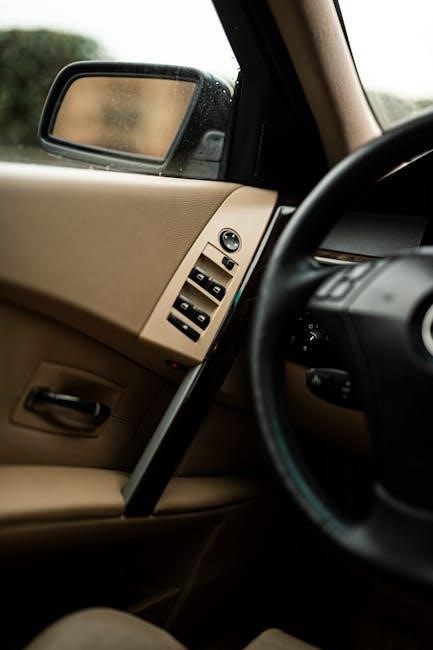The Hawaii Drivers Manual is an essential guide for new and experienced drivers, covering traffic laws, safe driving practices, and licensing procedures in the state.
It provides detailed information on road signs, rules of the road, and best practices to ensure safety for all drivers, pedestrians, and vehicles in Hawaii.
The manual is available online and in multiple formats, making it accessible to everyone preparing for a driver’s license or seeking to refresh their knowledge of Hawaii’s driving regulations.
Purpose and Importance of the Manual
The Hawaii Drivers Manual serves as a comprehensive guide to help residents prepare for driver’s license tests and understand traffic laws. It covers essential topics like road safety, driving regulations, and vehicle operation, ensuring drivers are well-informed. The manual is crucial for new drivers, as it provides the knowledge needed to pass written and road tests. It also serves as a reference for experienced drivers to refresh their understanding of Hawaii’s specific driving rules. By following the manual, drivers can reduce the risk of accidents and violations, contributing to safer roads across the state. Its importance lies in promoting responsible and informed driving practices.
Structure and Content Overview
The Hawaii Drivers Manual is organized into clear chapters, covering essential topics such as traffic laws, road signs, safe driving practices, and license requirements. It includes detailed sections on defensive driving techniques, handling emergency situations, and specific rules for different types of licenses, such as commercial and motorcycle licenses. The manual also provides information on vehicle registration, insurance mandates, and REAL ID compliance. With visual aids like diagrams and illustrations, it offers a user-friendly format to help drivers understand and apply the rules of the road effectively. Regular updates ensure the manual reflects the latest state driving regulations and safety guidelines.
Availability of the Manual in Multiple Formats
The Hawaii Drivers Manual is accessible in various formats to accommodate different preferences and needs. It is available online as a downloadable PDF, making it easy to access and study digitally. For those who prefer physical copies, the manual can be purchased in paperback form. Additionally, an audio version has been introduced to assist auditory learners. The manual is also offered in multiple languages to cater to Hawaii’s diverse population; These formats ensure that all residents can access the information conveniently, whether they prefer reading, listening, or carrying a physical copy. This accessibility helps everyone prepare effectively for their driver’s license exams.

Eligibility Requirements for a Hawaii Drivers License
To obtain a Hawaii driver’s license, applicants must meet specific requirements, including age, residency, and documentation standards, and pass medical and vision evaluations.
Age Requirements for Different License Types
In Hawaii, the minimum age to apply for a driver’s license varies by license type. A Commercial Driver’s License (CDL) requires applicants to be at least 21 years old. For a Motorcycle License, applicants must be 15 years and 6 months old to apply for a permit, with full licensure granted at 17. A Regular Passenger Vehicle License allows applicants as young as 15 years and 6 months to obtain a permit, with full licensure available at 17 years old. Minors must complete a driver’s education course and log supervised driving hours to meet requirements.
Residency and Documentation Requirements
To apply for a Hawaii driver’s license, applicants must prove residency and legal presence in the U.S. Required documents include proof of identity, birth date, and Hawaii residency. Acceptable documents include a valid passport, birth certificate, or Social Security card for identity, and utility bills or lease agreements for residency proof. Non-citizens must provide immigration documents, such as a green card or visa. All documents must be originals or certified copies. Additional requirements, such as a vision test, may apply. Ensure all paperwork is current and valid to avoid delays in the licensing process.
Medical and Vision Standards
Applicants for a Hawaii driver’s license must meet specific medical and vision standards to ensure safe driving. A vision test is required, with a minimum visual acuity of 20/40 in both eyes, and peripheral vision of 140 degrees. Certain medical conditions may require evaluation by a licensed medical professional to assess fitness to drive. Individuals with conditions such as epilepsy, diabetes, or heart issues must provide medical clearance. Failure to disclose medical conditions can result in license suspension. These standards are in place to protect public safety and ensure all drivers are physically capable of operating a vehicle safely.

Types of Drivers Licenses in Hawaii
Hawaii offers various driver’s licenses, including Commercial Driver’s Licenses, Motorcycle Licenses, and Regular Passenger Vehicle Licenses, each tailored to specific driving needs and requirements.
Commercial Drivers License (CDL)
A Commercial Driver’s License (CDL) in Hawaii is required for operating heavy-duty vehicles, including trucks, buses, and hazardous material transporters. The CDL classification includes Class A, B, and C licenses, each with specific endorsements for specialized cargo or passenger transport. Eligibility requires applicants to be at least 21 years old, meet medical standards, and pass rigorous written and skills tests. CDL holders must adhere to federal and state regulations, including hours of service and medical certification requirements. The manual provides detailed information on obtaining and maintaining a CDL, ensuring safe and professional operation of commercial vehicles in Hawaii.
Motorcycle License
To obtain a motorcycle license in Hawaii, applicants must meet specific requirements outlined in the manual. Riders under 18 are required to complete a motorcycle safety course. The manual details the process for obtaining a Class 2 (motorcycle) license, which includes passing a vision test, written exam, and road test. A Class 1 license is required for motorcycles over 100cc. Safety gear and traffic laws specific to motorcyclists are emphasized to ensure safe riding practices. The manual also covers endorsements for three-wheeled vehicles and the importance of following Hawaii’s motorcycle-specific regulations for road safety.
Regular Passenger Vehicle License
The regular passenger vehicle license in Hawaii is classified as a Class 3 license, allowing drivers to operate standard passenger vehicles. Applicants must be at least 15 years and 6 months old to apply for a learner’s permit. The manual outlines the steps to obtain this license, including passing a written knowledge test, vision exam, and road test. Restrictions apply during the first year of licensure, such as limiting the number of passengers under 18. The manual emphasizes the importance of following traffic laws and safe driving practices to ensure public safety on Hawaii’s roads.

Traffic Laws and Regulations
Hawaii’s traffic laws ensure road safety and order. The manual covers speed limits, right-of-way rules, seat belt requirements, and specific regulations for safe driving practices statewide.
Speed Limits and Right-of-Way Rules
Understanding speed limits and right-of-way rules is crucial for safe driving in Hawaii. The manual outlines maximum speed limits for highways, urban areas, and school zones, ensuring drivers adjust their speed according to road conditions. Right-of-way rules are clearly defined to prevent accidents at intersections and pedestrian crossings. Drivers must yield to emergency vehicles and pedestrians. The manual also explains when to stop or proceed cautiously, emphasizing the importance of adhering to traffic signs and signals. By following these guidelines, drivers can contribute to a safer and more orderly road environment across the islands.
- Always obey posted speed limits.
- Yield to pedestrians and emergency vehicles.
- Follow traffic signals and signs diligently.
Refer to the manual for detailed explanations and updates on traffic laws.
Seat Belt and Child Safety Laws
Hawaii’s seat belt and child safety laws prioritize the protection of all vehicle occupants. The manual emphasizes that all drivers and passengers must wear a seat belt, with specific regulations for children under the age of 8 or shorter than 4 feet 9 inches. Children must use approved child safety seats or booster seats until they meet the height requirement. Failure to comply with these laws can result in fines and penalties. The manual also outlines proper installation and usage guidelines for child restraints, ensuring maximum safety and reducing the risk of injury or fatality in the event of an accident.
- All occupants must wear a seat belt.
- Children under 8 or shorter than 4’9″ require approved restraints.
- Proper installation of child seats is mandatory.
Drunk Driving and DUI Regulations
Hawaii enforces strict laws against drunk driving to ensure road safety. The legal blood alcohol content (BAC) limit is 0.08% for drivers 21 and older. Underage drivers face a zero-tolerance policy, with any BAC above 0.02% resulting in penalties. DUI offenses carry severe consequences, including license suspension, fines, and mandatory ignition interlock devices. Repeat offenders face harsher penalties, including extended license revocation and increased fines. Refusing a breathalyzer test can result in an automatic license suspension. Hawaii also imposes criminal charges for DUI, emphasizing the importance of never driving under the influence of alcohol or drugs.
- Legal BAC limit: 0.08% for adults.
- Zero tolerance for underage drivers.
- Penalties include fines, license suspension, and ignition interlock devices.

Safe Driving Practices
Safe driving practices are crucial for ensuring road safety. Stay alert, follow speed limits, maintain a safe distance, and always use turn signals. Avoid distractions like texting while driving. Respect road signs and adjust your speed according to weather conditions. Defensive driving habits help prevent accidents and protect all road users.
Defensive Driving Techniques
Defensive driving techniques are essential for maintaining road safety in Hawaii. Stay alert, anticipate other drivers’ actions, and maintain a safe following distance. Always be prepared to react to unexpected situations. Avoid distractions like texting or eating while driving. Adjust your speed according to weather and road conditions. Use turn signals consistently to communicate your intentions. Keep a safe distance from pedestrians, cyclists, and motorcycles. Be cautious at intersections and yield the right-of-way when necessary. Defensive driving helps prevent accidents and ensures a safe environment for all road users. By practicing these techniques, you contribute to reducing risks and enhancing overall traffic safety.
Handling Emergency Situations
Handling emergency situations requires calm and quick thinking. If your vehicle breaks down, move to a safe location and use hazard lights. Keep an emergency kit with a flashlight, first aid supplies, and reflective triangles. In case of an accident, remain at the scene, provide assistance, and contact authorities. For medical emergencies, call 911 immediately. Be prepared for natural disasters like earthquakes or tsunamis by knowing evacuation routes. Stay informed about weather conditions and avoid driving through flooded areas. Always prioritize safety and follow proper procedures to protect yourself and others in emergency situations.
Night and Wet Weather Driving Tips
Night driving requires extra caution due to reduced visibility. Use low beams when approaching other vehicles and avoid overdriving your headlights. Keep windshield and windows clean for clear vision. In wet weather, reduce speed and increase following distance, as roads become slippery. Avoid sudden movements and steer smoothly. Use windshield wipers and defroster to maintain visibility. Be cautious of standing water, which can cause hydroplaning; Never drive through flooded areas if depth is unknown. Stay alert for pedestrians and cyclists, who may be harder to see. Keep emergency supplies like a flashlight and reflective triangles in your vehicle. Always prioritize safety in adverse conditions.

Preparing for the Written Test
Study the Hawaii Drivers Manual thoroughly to understand traffic laws, road signs, and safe driving practices. Practice with online tests to assess readiness and review weak areas.
Key Topics Covered in the Written Exam
The written exam covers essential topics from the Hawaii Drivers Manual, including traffic laws, road signs, and safe driving practices.
It tests knowledge of speed limits, right-of-way rules, and seat belt laws.
Additional topics include understanding traffic signals, pedestrian safety, and emergency driving procedures.
The exam also addresses Hawaii-specific driving scenarios and legal requirements.
Applicants must demonstrate a clear understanding of these concepts to pass the test and obtain their permit or license.
Study Tips and Resources
To prepare for the written exam, thoroughly review the Hawaii Drivers Manual, focusing on traffic laws and road signs.
Utilize online practice tests to assess your knowledge and identify areas for improvement;
Leverage interactive study guides and AI-powered tools for personalized learning.
Take advantage of audio versions of the manual for on-the-go study.
Review the handbook’s glossary and summaries to reinforce key concepts.
Practice consistently and focus on understanding rather than memorization.
Additionally, seek study groups or tutoring for extra support if needed.
Practice Tests and Online Tools
Enhance your preparation with official Hawaii Drivers Manual practice tests and online tools.
These resources offer interactive tests, progress tracking, and immediate feedback.
Utilize AI-powered assistants for personalized study support and clarification of complex topics.
Take advantage of audio versions for on-the-go learning.
Access mobile apps designed for convenient study anywhere.
Engage with community forums for shared tips and experiences.
Regularly review practice test results to focus on areas needing improvement.
These tools ensure a comprehensive understanding of the manual and boost confidence for the written exam.

Behind-the-Wheel Training and Road Test
The Hawaii Drivers Manual emphasizes the importance of behind-the-wheel training and road test preparation.
It outlines essential driving skills, such as maneuvering, parking, and safe navigation.
The manual provides tips for vehicle inspection and readiness.
Practicing these skills ensures confidence and readiness for the road test evaluation.
Regular training and review of the manual are key to successful completion of the driving assessment.
Skills Required for the Road Test
The Hawaii Drivers Manual outlines the essential skills needed for the road test, ensuring drivers demonstrate competence and safety.
Key skills include parallel parking, three-point turns, merging onto highways, and following traffic signals.
Drivers must show ability to maintain proper lane position, check mirrors, and signal correctly.
The test evaluates adherence to traffic laws, vehicle control, and awareness of surroundings.
Consistent practice of these skills is crucial for passing the assessment.
Failing to perform tasks safely may result in retaking the test.
Regular review of the manual and focused practice enhance readiness for the evaluation.
Common Mistakes to Avoid
During the road test, common mistakes include failing to check mirrors and blind spots, improper signaling, and speeding.
Many drivers also make errors in parallel parking, such as poor alignment or insufficient space.
Forgetting to yield to pedestrians or other vehicles is another frequent issue.
Inconsistent speed control, especially on hills or curves, can lead to failure.
Nervousness often causes hesitation at stoplights or intersections, which examiners may view as unsafe behavior.
Practicing these areas and staying calm can help minimize errors and improve chances of passing the test.
Preparing Your Vehicle for the Test
Ensure your vehicle is in good working condition for the road test. Check brakes, tires, lights, and signals to confirm they function properly.
The car must be registered and have valid insurance. Remove any obstructions that could block your view or the examiner’s.
Clean the windshield and ensure all mirrors are adjusted for clear visibility.
The vehicle must meet Hawaii’s safety standards and be appropriate for the type of license you’re applying for.
Failing to prepare your vehicle correctly may result in test cancellation.
Double-check everything before arriving to avoid delays or issues during the exam.

Vehicle Registration and Insurance
Vehicle registration and insurance are essential for legal driving in Hawaii. Annual registration and liability insurance are required, verified during the DMV process. Compliance ensures road safety.
Registration Requirements and Fees
Registering a vehicle in Hawaii requires proof of insurance, residency, and a safety inspection. Annual registration fees vary by vehicle type and weight, with additional fees for special plates. Late payments incur penalties. For most passenger vehicles, fees range between $200 and $300, while commercial or heavy vehicles cost more. Payments can be made online, by mail, or in person at DMV offices. Ensure all documentation is up-to-date to avoid delays or fines, and check the Hawaii DMV website for the most current fee schedule and requirements.
Minimum Insurance Coverage Mandates
In Hawaii, drivers must carry minimum liability insurance coverage of $20,000 for bodily injury per person, $40,000 per accident, and $10,000 for property damage. Uninsured/underinsured motorist coverage is also mandatory, with minimum limits of $20,000/$40,000. Additionally, Hawaii is a no-fault state, requiring Personal Injury Protection (PIP) coverage to cover medical expenses regardless of fault. Drivers must provide proof of insurance when registering a vehicle, renewing a license, or during traffic stops. Failure to maintain coverage can result in penalties, fines, or license suspension. Always verify your policy meets Hawaii’s legal requirements to avoid enforcement actions.
Consequences of Driving Without Insurance
Driving without insurance in Hawaii can result in severe penalties, including fines ranging from $300 to $1,000. Your driver’s license may be suspended for up to three months, and your vehicle registration could be revoked. Additionally, you may be required to file an SR-22 form, proving future insurance coverage for three years. Repeat offenses can lead to increased fines and longer license suspensions. If involved in an accident without insurance, you may face civil penalties and be held personally liable for damages. Compliance with insurance mandates is crucial to avoid these consequences and ensure legal driving privileges in Hawaii.

Special Considerations
The Hawaii Drivers Manual addresses REAL ID compliance, rules for international and out-of-state drivers, and procedures for license renewal and reinstatement after suspension or revocation.
REAL ID Compliance and Requirements
The Hawaii Drivers Manual outlines the importance of REAL ID compliance, a federal standard for driver’s licenses and ID cards; As of May 2025, a REAL ID-compliant license or ID card will be required for domestic air travel and access to federal facilities. To apply, residents must provide proof of identity, residency, and legal presence in the U.S. Hawaii offers a REAL ID-compliant option for driver’s licenses, ensuring compliance with federal regulations. Additionally, the state has introduced digital driver’s licenses, which are available through Apple Wallet, though physical licenses are still required for certain purposes.
International Drivers and Out-of-State Transfers
International drivers may drive in Hawaii with a valid foreign license for up to one year. To obtain a Hawaii driver’s license, international applicants must provide proof of identity, residency, and legal status. Out-of-state drivers transferring their license must surrender their previous license, provide documentation, and pass vision and written tests. The Hawaii Drivers Manual details these requirements, ensuring compliance with state regulations. Additional resources, such as the DMV handbook, offer guidance for international and out-of-state applicants seeking to navigate the licensing process smoothly in Hawaii.
License Renewal and Reinstatement Procedures
Hawaii driver’s licenses can be renewed online, by mail, or in person at a DMV office. Licenses typically expire every 8 years for individuals under 72, with a 90-day grace period. To renew, applicants must provide proof of identity, residency, and legal presence. For reinstatement of a suspended or revoked license, drivers must fulfill specific requirements, such as completing a driver education course or paying reinstatement fees. The Hawaii Drivers Manual outlines these procedures in detail, ensuring drivers can maintain or regain their driving privileges in compliance with state regulations. Timely renewal is essential to avoid penalties and ensure continuous legal driving privileges.

Additional Resources and Support
The Hawaii Drivers Manual offers online tools, practice tests, and community programs to aid drivers. DMV offices provide further assistance, ensuring all drivers have access to support resources.
Online Manuals and Guides
The Hawaii Drivers Manual is available online in digital formats, including PDF and audio versions, making it accessible to all residents. The manual is regularly updated to reflect current laws and regulations.
Interactive study tools, such as practice tests and AI-driven assistance, are provided to help learners prepare for exams and understand complex topics like traffic rules and safe driving practices.
Additional resources include online guides for commercial and motorcycle licenses, ensuring specialized drivers can access tailored information to meet their specific needs and requirements.
These digital resources are designed to make learning convenient and effective, supporting drivers in achieving their licensing goals efficiently.
DMV Office Locations and Contact Information
Hawaii DMV offices are located across the islands, with major locations in Hilo, Kona, and Waimea. These offices provide services for driver’s licenses, vehicle registration, and other DMV-related tasks.
Residents can visit the official Hawaii DMV website to find the nearest office, check hours of operation, and schedule appointments. Contact information, including phone numbers and email addresses, is also available online.
For convenience, many services can be initiated online, reducing wait times. Walk-in appointments are possible, but scheduling in advance is recommended to ensure timely service.
Community and Safety Programs
The Hawaii Department of Transportation offers various community and safety programs to promote road safety and responsible driving. These initiatives include traffic safety campaigns, educational workshops, and partnerships with local organizations to address issues like speeding, drunk driving, and pedestrian safety.
The state also provides resources for new drivers, such as defensive driving courses and outreach programs to ensure compliance with traffic laws. Additionally, Hawaii supports REAL ID compliance and digital driver’s license options to enhance security and convenience for residents;